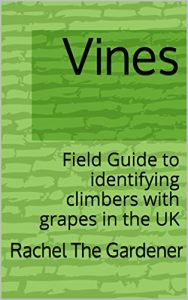“There are grapes growing in the wild?”
Oh yes – for a start, the ancestor of our cultivated grape! But more common is Woodbine, which is also known as False Virginia Creeper. Which begs the question, what's the difference between it, and Real Virginia Creeper? And what about Boston Ivy, isn't that the same as Virginia Creeper?
Those three are all Parthenocissus (“Parthenocissi”? “Parthenocissuses”?) but not all have palmate leaves: and they all have tendrils, but not all of them have sucker pads. Here is your chance to find out which is which, and what the differences are, along with two types of Vitis or grape, and Russian Vine is thrown in for good measure: all with the differences neatly laid out and carefully explained, in simple, non-technical language.
Well, ok, there is some botanical jargon, but honestly, it's explained very simply and calmly, and in no time at all you will understand what the jargon means and, more importantly, you will be able to impress your friends with your ability to identify woody climbers in the wild!
Some of the plants in this set are garden plants, rather than wild ones: but they are increasingly escaping from gardens and enjoying themselves in our hedgerows, and along the paths, tracks, towpaths and disused railways of the UK: these areas are great resources for Botanists, as the flowers which grow along them can be visited for free, year after year, so you can track the development of annual plants, and observe the growth of perennials ones.
This Field Guide is one of a series of books intended for use in the field by UK Botanists, both Improvers and complete beginners, to help swiftly narrow down the identification of a plant, and to extend your knowledge and understanding of the genus.
They cover commonly found UK species, and are not intended to replace a full-length Field Guide such as Poland or Rose: but they present the salient information in an easy-to-read format, to people who have gone beyond having to key out every single plant, and who are now trying to learn the difference between species.
The Kindle is the perfect format for this, as you can look up any words you don't understand in the Kindle dictionary, and then annotate the Table to remind yourself.
Originally they were in the form of a pack of A6 cards on a ring, and you may prefer to print out the Crib to take with you: but if you can take your Kindle out botanising with you, then so much the better!
Oh yes – for a start, the ancestor of our cultivated grape! But more common is Woodbine, which is also known as False Virginia Creeper. Which begs the question, what's the difference between it, and Real Virginia Creeper? And what about Boston Ivy, isn't that the same as Virginia Creeper?
Those three are all Parthenocissus (“Parthenocissi”? “Parthenocissuses”?) but not all have palmate leaves: and they all have tendrils, but not all of them have sucker pads. Here is your chance to find out which is which, and what the differences are, along with two types of Vitis or grape, and Russian Vine is thrown in for good measure: all with the differences neatly laid out and carefully explained, in simple, non-technical language.
Well, ok, there is some botanical jargon, but honestly, it's explained very simply and calmly, and in no time at all you will understand what the jargon means and, more importantly, you will be able to impress your friends with your ability to identify woody climbers in the wild!
Some of the plants in this set are garden plants, rather than wild ones: but they are increasingly escaping from gardens and enjoying themselves in our hedgerows, and along the paths, tracks, towpaths and disused railways of the UK: these areas are great resources for Botanists, as the flowers which grow along them can be visited for free, year after year, so you can track the development of annual plants, and observe the growth of perennials ones.
This Field Guide is one of a series of books intended for use in the field by UK Botanists, both Improvers and complete beginners, to help swiftly narrow down the identification of a plant, and to extend your knowledge and understanding of the genus.
They cover commonly found UK species, and are not intended to replace a full-length Field Guide such as Poland or Rose: but they present the salient information in an easy-to-read format, to people who have gone beyond having to key out every single plant, and who are now trying to learn the difference between species.
The Kindle is the perfect format for this, as you can look up any words you don't understand in the Kindle dictionary, and then annotate the Table to remind yourself.
Originally they were in the form of a pack of A6 cards on a ring, and you may prefer to print out the Crib to take with you: but if you can take your Kindle out botanising with you, then so much the better!



